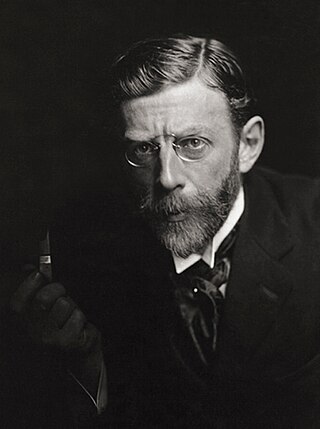
Impressionism was a 19th-century art movement characterized by relatively small, thin, yet visible brush strokes, open composition, emphasis on accurate depiction of light in its changing qualities, ordinary subject matter, unusual visual angles, and inclusion of movement as a crucial element of human perception and experience. Impressionism originated with a group of Paris-based artists whose independent exhibitions brought them to prominence during the 1870s and 1880s.

Mary Stevenson Cassatt was an American painter and printmaker. She was born in Allegheny, Pennsylvania, but lived much of her adult life in France, where she befriended Edgar Degas and exhibited with the Impressionists. Cassatt often created images of the social and private lives of women, with particular emphasis on the intimate bonds between mothers and children.

Georges Pierre Seurat was a French post-Impressionist artist. He devised the painting techniques known as chromoluminarism and pointillism and used conté crayon for drawings on paper with a rough surface.

Frédéric Auguste Bartholdi was a French sculptor and painter. He is best known for designing Liberty Enlightening the World, commonly known as the Statue of Liberty.

Alexandre Cabanel was a French painter. He painted historical, classical and religious subjects in the academic style. He was also well known as a portrait painter. According to Diccionario Enciclopedico Salvat, Cabanel is the best representative of L'art pompier, and was Napoleon III's preferred painter.

Charles Sydney Hopkinson was an American portrait painter and landscape watercolorist. He maintained a studio in the Fenway Studios building in Boston from 1906 to 1962. He painted over 800 portraits in a direct style with a palette gradually lightening through his career. Many of his paintings were commissioned by U. S. East Coast institutions, especially Harvard University, where he acted as house portraitist. Among his sitters were Oliver Wendell Holmes, Calvin Coolidge, Lewis Perry and John Masefield.

Morgan Russell was a modern American artist. With Stanton Macdonald-Wright, he was the founder of Synchromism, a provocative style of abstract painting that dates from 1912 to the 1920s. Russell's "synchromies," which analogized color to music, were an early American contribution to the rise of Modernism.

The Salon, or rarely Paris Salon, beginning in 1667 was the official art exhibition of the Académie des Beaux-Arts in Paris. Between 1748 and 1890 it was arguably the greatest annual or biennial art event in the Western world. At the 1761 Salon, thirty-three painters, nine sculptors, and eleven engravers contributed. From 1881 onward, it was managed by the Société des Artistes Français.

Jules Adolphe Aimé Louis Breton was a 19th-century French naturalist painter. His paintings are heavily influenced by the French countryside and his absorption of traditional methods of painting helped make Jules Breton one of the primary transmitters of the beauty and idyllic vision of rural existence.

Henry Ossawa Tanner was an American artist who spent much of his career in France. He became the first African-American painter to gain international acclaim. Tanner moved to Paris, France, in 1891 to study at the Académie Julian and gained acclaim in French artistic circles. His painting Daniel in the Lions' Den was accepted into the 1896 Salon, the official art exhibition of the Académie des Beaux-Arts in Paris. Tanner's Resurrection of Lazarus was purchased by the French government after winning the third-place medal at the 1897 Salon. In 1923, the French government elected Tanner chevalier of the Legion of Honor.

Julius Garibaldi Melchers was an American artist. He was one of the leading American proponents of naturalism. He won a 1932 Gold medal from the American Academy of Arts and Letters.

Paul Durand-Ruel was a French art dealer associated with the Impressionists and the Barbizon School. Being the first to support artists such as Claude Monet, Camille Pissarro, and Pierre-Auguste Renoir, he is known for his innovations in modernizing art markets, and is generally considered to be the most important art dealer of the 19th century. An ambitious entrepreneur, Durand-Ruel cultivated international interest in French artists by establishing art galleries and exhibitions in London, New York, Berlin, Brussels, among other places. Additionally, he played a role in the decentralization of art markets in France, which prior to the mid-19th century was monopolized by the Salon system.

David Johnson was an American painter, a member of the second generation of Hudson River School painters.

Pierre-Georges Jeanniot (1848–1934) was a Swiss-French Impressionist painter, designer, watercolorist, and engraver who was born in Geneva, Switzerland, and died in France. His work often depicts the modern life in Paris.

Leon Dabo was an American tonalist landscape artist best known for his paintings of New York, particularly the Hudson Valley. His paintings were known for their feeling of spaciousness, with large areas of the canvas that had little but land, sea, or clouds. During his peak, he was considered a master of his art, earning praise from John Spargo, Bliss Carman, Benjamin De Casseres, Edwin Markham, and Anatole Le Braz. His brother, Scott Dabo, was also a noted painter.

Ángel Zárraga (y) Argüelles was a Mexican painter. He was a founding member of the cultural organization El Ateneo de la Juventud. His work was part of the art competitions at the 1928 Summer Olympics and the 1932 Summer Olympics.

William Anderson Coffin (1855–1925) was an American landscape and figure painter. He also was an art critic, working for the New York Post and Harper's Weekly. In 1917 he would be awarded the French Legion of Honor.

Henry Seymour Chase Jr., better known by his professional name Harry Chase, was an American artist who specialized in marine paintings.

Clifford Prevost Grayson was an American painter and teacher.



















